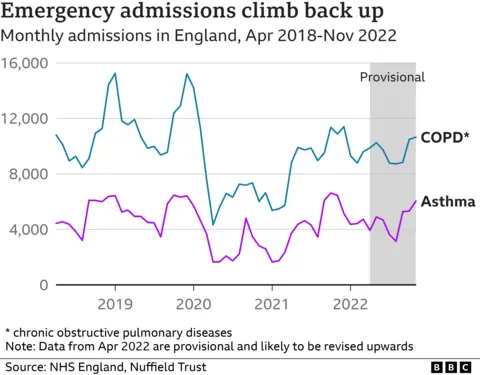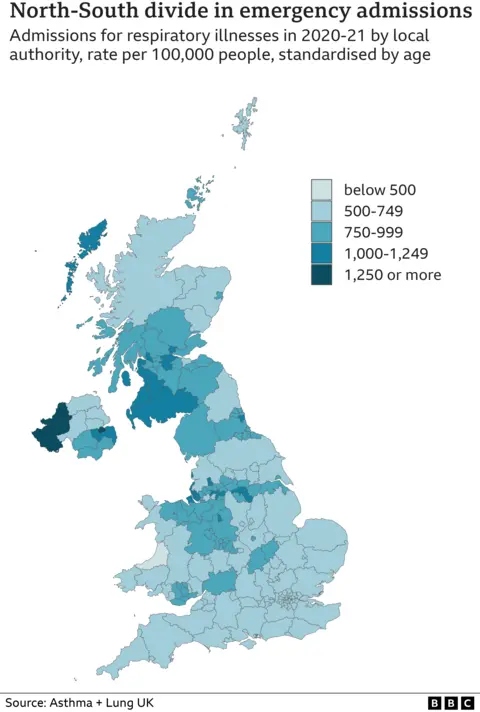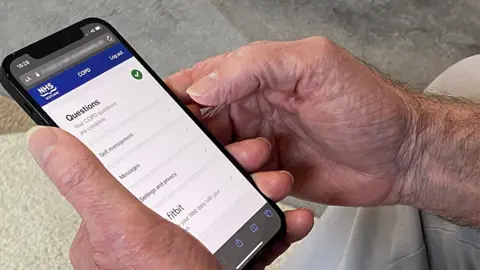Lung disease: 'For asthma to take her life was just unbelievable'
 Family photo
Family photoThe number of people needing emergency hospital treatment for asthma, emphysema and other lung conditions is three times higher in some parts of the UK than in the richest areas of the country, new research has shown.
A detailed picture of lung health found much higher illness and death rates in the north-west of England, the central belt of Scotland and parts of Northern Ireland, according to a lung disease charity.
Amy Greenwood was meant to get married in June.
The 22-year-old from Skelmersdale in Lancashire had been living with severe asthma since she was a toddler.
She was very careful throughout the pandemic - shielding and waving to her mum from the doorstep like so many others.
One day last October, she started feeling wheezy with a tight chest, but by the evening her breathing was much better, and she went to bed after a long shower.
That night her fiance Keagan went upstairs after hearing a thump to find her unconscious on the floor. He called an ambulance and then phoned Amy's parents who lived around the corner.
"I just hung up, got dressed and raced round," said her mum Joanne.
"I went in, and she was lying in the doorway of the bedroom, upstairs on the landing. Keagan was doing CPR and she wasn't breathing."
 Family photo
Family photoParamedics arrived and managed to get Amy's heart started again before rushing her to hospital.
But her brain had been starved of oxygen for too long. Two days later her life support was switched off.
She left behind two young children - aged four and 18 months old.
"For asthma to take her life was unbelievable," said Joanne. "I just didn't think it was possible in this day and age, but I was wrong."

Lung conditions such as asthma and chronic obstructive pulmonary disease (COPD), a category which includes emphysema and chronic bronchitis, affect one in five people in their lifetime.
Lung disease is the third biggest killer in the UK after cancer and heart disease over the last decade. In Lancashire - where Amy lived - rates are above the national average.
During the pandemic, the number of hospital admissions fell sharply as those most at-risk shielded from Covid, while lockdown also suppressed other viruses which can set off a serious asthma attack.
At the same time, it is thought another trigger - air pollution - improved, as industry shut down and roads cleared of traffic.
But the latest figures show admissions now creeping back to pre-pandemic levels, a trend doctors describe as "deeply worrying".

Research from the charity Asthma and Lung UK (ALUK) found parts of north-west England, central Scotland and Northern Ireland had double the rate of admissions and almost triple the rate of deaths as parts of London and the South East.
The evidence shows there is a strong link to deprivation, according to ALUK's chief executive Sarah Woolnough.
"There will often be higher exposure to air pollution, poor quality housing with mould and damp that can lead to flare-ups, and historically higher smoking rates," she said.
"We also know that people have different access to GPs and primary care. And for lung health, getting a quick diagnosis and then access to care to manage your condition is so important."
The government angered some doctors in January when it said it would shelve a long-awaited white paper which was meant to spell out how it would tackle these kinds of health inequalities in England.
In its place, a new "major conditions" strategy is due to be published this summer, looking at improving treatment for those people already experiencing ill health, and taking into account regional differences.
Ministers say they have already set "ambitious" targets to reduce air pollution and smoking, while the NHS is also expanding its programme of free lung health checks in England.
Across the whole UK, the cost to the health service of lung disease is put at £11bn a year, with COPD alone now the second most common reason for an emergency hospital admission.
If just a fraction of those patients could be kept out of A&E, then it could save the NHS many millions of pounds.

In Greater Glasgow and Clyde, about 500 people with COPD are being monitored at home, in a pioneering scheme designed to pick up health problems early.
Users are asked to install a smartphone app which lets them message doctors with any concerns, and are texted every day with a reminder to answer questions about their symptoms.
The system then combines that information with patient records and real-time data from fitness trackers, internet-connected home ventilators and other breathing equipment.
Dr Chris Carlin, a consultant respiratory physician at Queen Elizabeth University Hospital in Glasgow and one of the team behind the idea, said it meant highly vulnerable patients felt better protected.
"They know that when they have a flare-up in their symptoms, they don't need to press the crisis button, they don't need to present themselves to the emergency department," he said.

The technology, developed by the Scottish digital health start-up Lenus, has also been rolled out in Lothian and the Highlands and just started to be used in Hull.
Early results suggest hospital admissions have been cut by 54% in the group of patients enrolled in Glasgow, which has some of the highest rates of lung disease in the country.
A new trial this year will start to use artificial intelligence algorithms to analyse all this data in real-time, automatically flagging up patients who might be starting to struggle with their breathing.
"If we can manage these patients more safely and effectively with digital tools, it's ultimately beneficial to them and it's beneficial to the whole NHS," said Dr Carlin.
"If we do nothing, the costs of COPD are going to increase dramatically over the next 20 or 30 years, and we just can't afford that."
You can follow Jim on twitter.
Data visualisation by Becky Dale.
